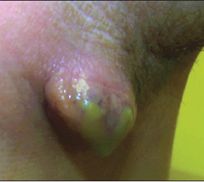What Is This Axillary Lump?
An overweight 13-year-old girl, with a body mass index of 29, presented with a lump in her axilla for the fourth time in the past several months. This time, the lump recurred in the left axilla; it had developed in the right axilla on 2 other occasions.
THE CASE: An overweight 13-year-old girl, with a body mass index of 29, presented with a lump in her axilla for the fourth time in the past several months. This time, the lump recurred in the left axilla; it had developed in the right axilla on 2 other occasions. Findings from her physical examination were otherwise normal. During the next week, the lump enlarged and then spontaneously drained, following the same course as the previous lumps. There was no family history of such a condition.


Answer and discussion on next page.
Hidradenitis suppurativa is the correct answer.


DISCUSSION: Hidradenitis suppurativa is a chronic, relapsing disease associated with follicular occlusion.1,2 As in this patient, the disease often begins during puberty and is characterized by the recurrence of painful nodules in the areas of the body where apocrine glands are found (axilla, groin, buttocks, breasts, shoulders, neck). Among other factors, including genetics, obesity has been found to be associated with this condition.3
Treatment depends on the severity of the condition. Prescription antibiotics and local wound care, including incision and drainage of lesions, can provide relief for patients with mild symptoms. Severe cases may require more intensive interventions (retinoids, hormones, immunosuppressives, anti-inflammatory agents, surgery) and should be managed by a dermatologist.1,2
Although Fox-Fordyce disease can also occur in the axilla, its clinical presentation is distinctly different. This dermatological disease is characterized by a crop of pruritic papules. Folliculitis, or inflammation of hair follicles, appears as one or more papules or small pustules with surrounding erythema. One of the features of chronic granulomatous disease may be recurrent lymphadenitis, but this immune disorder is also associated with other recurrent infections with unusual pathogens. Evidence of GI involvement is lacking at this point in the patient’s history, so a diagnosis of Crohn disease (which may also be associated with hidradenitis suppurativa) is not supported.
Case and images courtesy of Linda S. Nield, MD, of West Virginia University School of Medicine in Morgantown.
References:
REFERENCES:
1. Alikhan A, Lynch PJ, Eisen DB. Hidradenitis suppurativa: a comprehensive review. J Am Acad Dermatol. 2009;60:539-561.
2. Keri JE, Nield LS. Acne, rosacea and hidradenitis suppurativa. In: Schwarzenberger K, Werchniak AE, Ko CJ, eds. General Dermatology: Requisites in Dermatology. Philadelphia: Saunders Elsevier; 2009:305-313.
3. Revuz JE, Canoui-Poitrine F, Wolkenstein P, et al. Prevalence and factors associated with hidradenitis suppurativa: results from two case-control studies. J Am Acad Dermatol. 2008;59:596-601.
RELATED CONTENT:
• Sabnis H, Kamat DM. What’s Your Diagnosis? Teen with multiple boils.Consultant For Pediatricians. 2007;6:231-236.
• Nahavandi AA, Nahavandi AA. Photoclinic: hidradenitis suppurativa. Consultant. 2007;47:1190.
• Levine R. Photoclinic: hidradenitis suppurativa.Consultant. 2005;45:406.